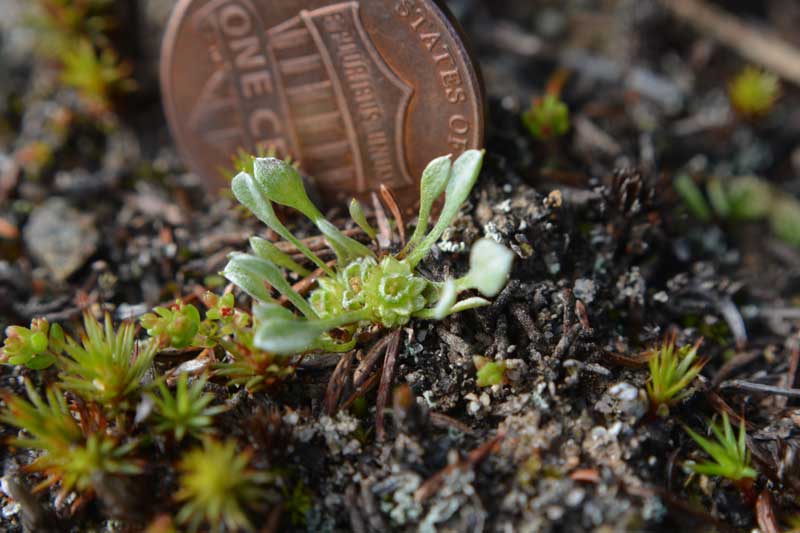Hallada la única población conocida de una planta autóctona de California poco común que no se había documentado en casi 30 años
"Un hallazgo verdaderamente emocionante". Hasta ahora no existían fotos de Ancistrocarphus keilii vivos.

17 de mayo de 2023, Sacramento-Hoy, la Sociedad de Plantas Autóctonas de California (CNPS) y el Jardín Botánico de Santa Bárbara (el Jardín) anunciaron el "redescubrimiento" de una especie de planta autóctona no documentada en décadas. Antes del nuevo hallazgo, la estrella de tierra de Santa Ynez(Ancistrocarphus keilii, CRPR 1B.1) sólo se conocía por registros muy antiguos y una o dos apariciones.
Recientemente, colaboradores del CNPS y del Jardín, entre ellos la directora del Programa de Plantas Raras del CNPS, Kristen Nelson, el sistemático del Jardín Botánico de Santa Bárbara Ken y Shirley Tucker y el conservador del herbario Clifton Smith, el Dr. Matt Guilliams, los técnicos de plantas raras del Jardín Botánico de Santa Bárbara Sean Carson y Kevin Mason, y la botánica jefe del Centro de Gestión Medioambiental de Tierras Militares, la Dra. Sarah DeGroot. Sarah DeGroot, recopilaron información de registros antiguos y fuentes primarias y obtuvieron permisos para buscar en el lugar de la Base Vandenberg de las Fuerzas Espaciales (VSFB) donde se sabía que existía la planta. La búsqueda se coordinó con Luanne Lum, botánica de la VSFB. La información sobre la ubicación proporcionada por el Dr. Dieter Wilken, investigador asociado del Jardín Botánico de Santa Bárbara, hizo que la reubicación fuera relativamente fácil, dijo el equipo - "¡un hallazgo realmente emocionante!", dijo Nelson.
La estrella de tierra de Santa Ynez se describió originalmente como una nueva especie en 2004 a partir del análisis de especímenes secos (que es a menudo la forma en que se descubren nuevas especies). El Dr. Wilken es la única persona que ha visto la estrella de tierra desde su reconocimiento como especie distinta, y sólo unos pocos botánicos vivos la habían visto en la naturaleza antes de su clasificación como nueva especie.
"Plantas como ésta están o podrían estar al borde de la extinción y sólo podemos decir con seguridad que están bien una vez que ponemos los ojos sobre el terreno y las encontramos", dijo el Director del Programa de Plantas Raras del CNPS, Aaron Sims. "Aunque se ha encontrado esta especie, la población es extremadamente limitada y es importante que no se produzcan cambios en el uso del suelo".
Actualizar los datos obsoletos sobre la presencia de plantas puede requerir un esfuerzo y una investigación considerables, pero son fundamentales para orientar los esfuerzos de conservación y evitar la extinción de especies. Según un informe reciente de NatureServe, el 34% de las plantas de Estados Unidos están en peligro de extinción, y las de California son las que corren mayor riesgo. "Al llamar la atención sobre ellas, recopilar nuevos datos y fomentar la atención y las medidas de conservación, estas especies tienen muchas posibilidades de sobrevivir", añade Aaron Sims.
"Fue un verdadero placer encontrar y observar la estrella de tierra de Santa Ynez en la naturaleza", dice el Dr. Guilliams. "Las plantas son bastante pequeñas y pasan desapercibidas la mayor parte del año. Esperamos seguir buscando nuevas poblaciones de esta rara planta para poder estudiar y aprender más sobre su papel en la naturaleza y la mejor forma de protegerla."
Guilliams y sus colegas han recogido nuevos especímenes de la estrella de tierra para depositarlos en cuatro herbarios regionales: el Jardín Botánico de Santa Bárbara, el Herbario Hoover de la Universidad Politécnica Estatal de California en San Luis Obispo, el Herbario del Jardín Botánico de California y el herbario del VSFB. También se están actualizando los datos de población a medida que se orientan hacia la conservación y los bancos de semillas de la especie. Para obtener más información sobre plantas autóctonas de California raras o en peligro de extinción, visite https://www.cnps.org/rare-plants.
# # #
La Sociedad de Plantas Nativas de California es una organización estatal que promueve la comprensión, apreciación y protección de las plantas y hábitats nativos de California a través de la ciencia, la educación, la horticultura y la conservación. La CNPS cuenta con más de 50.000 seguidores y partidarios, y 36 capítulos que promueven su misión en todo California y Baja California, México. Más información en cnps.org.
El Jardín Botánico de Santa Bárbara, el primer jardín botánico del país dedicado exclusivamente a las plantas autóctonas, lleva casi un siglo trabajando para comprender mejor la relación entre las plantas y las personas. El jardín, que en 1926 contaba con 13 acres y hoy tiene 78, incluye más de 8 km de senderos, un herbario, un banco de semillas, laboratorios de investigación, una biblioteca y un vivero público de plantas autóctonas. En medio de la serena belleza del Jardín, equipos de científicos, educadores y horticultores siguen comprometidos con el espíritu original de los fundadores de la organización: conservar las plantas y los hábitats autóctonos de California para garantizar que sigan sustentando la vida en el planeta y que las generaciones venideras puedan disfrutar de ellos. Visite www.SBBotanicGarden.org.
 Donar
Donar